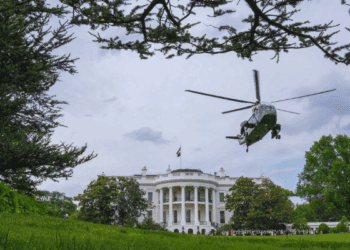This article was originally published for the Australian Institute of International Affairs.
By Stephen Nagy, April 22, 2025
As Canada approaches its 28 April Federal election, the policy implications extend far beyond a simple changing of the guard. This contest between Conservative leader Pierre Poilievre and unelected Liberal Party leader, and prime minister, Mark Carney, will determine whether Canada can reverse a decade of economic underperformance and diplomatic decline that has diminished its global standing.
The economic policy contrast between candidates is stark. Carney, with his central banking background, approaches governance through a macroeconomic lens that has prioritized climate finance, regulatory frameworks, and theoretical growth models over tangible middle-class prosperity. Statistics tell the story: despite 11.4 percent GDP growth between 2015-2024, median household income grew just 3.7 percent in real terms, revealing a troubling disconnect between headline economic indicators and lived experience of Canadian citizens and residents.
Poilievre’s economic platform centers on addressing structural impediments to growth that have festered under former Liberal Party Prime Minister Justin Trudeau’s government. Canadian labour productivity declined 0.8 percent between 2015 and 2023, a worrying trend in an increasingly competitive global economy. His proposed solutions—tax simplification, regulatory streamlining, and accelerated infrastructure approvals—reflect orthodox economic thinking but raise implementation questions given his lack of executive management experience.
The housing affordability crisis represents perhaps the most pressing domestic policy challenge. With average home prices increasing 87 percent over the past decade, both candidates have presented interventions. Carney advocates expanding the federal role in housing development through financing mechanisms similar to those he championed at the Bank of England. Poilievre proposes tying federal infrastructure funding to municipal zoning reform while reducing immigration volumes that have outpaced housing supply.
Immigration policy presents another significant divergence. The Trudeau government’s aggressive targets reaching 500,000 annual immigrants by 2023 have strained housing markets, infrastructure, and public services. While both candidates acknowledge these strains, their solutions differ markedly.
Carney defends high immigration targets as demographically necessary but proposes redirecting settlement toward smaller communities through enhanced regional programs. His approach maintains the status quo volume while adjusting distribution mechanisms. Poilievre advocates reducing immigration targets by approximately 30 percent until housing and infrastructure can accommodate current residents, while prioritising skilled immigrants with proven integration potential.
This policy choice carries enormous implications for Canada’s labour market, housing affordability, and social cohesion. The Parliamentary Budget Office’s December 2024 fiscal analysis indicates that current immigration levels without corresponding infrastructure investment will exacerbate housing shortages and suppress wage growth for lower-skilled workers.
Perhaps nowhere is policy correction more urgently needed than in defence and foreign affairs. Canada’s defence spending remains stubbornly below 1.4 percent of GDP—far short of NATO’s two percent target—while procurement processes have become notorious for delays and cost overruns. The current fighter jet acquisition, initiated in 2010, remains incomplete fifteen years later.
Poilievre commits to reaching NATO’ two percent threshold within five years through accelerated procurement and force expansion. His platform emphasises strengthened continental defence cooperation with the United States and increased naval presence in the Indo-Pacific. Carney proposes more modest defence increases focused on specialied capabilities rather than across-the-board expansion, prioritising climate security, cyber defence, and Arctic sovereignty.
Foreign policy orientation reveals further contrasts. Carney’s approach emphasises economic diversification beyond the American market through deepened European and Asian trade relationships. This strategy, while theoretically sound, confronts mathematical reality: even doubling EU trade would offset only a fraction of American market disruption given that 77 percent of Canadian exports flow southward.
More concerning is Carney’s ambiguous position on China, reflected in his reluctance to address foreign interference operations documented in parliamentary intelligence reports. This suggests potential continuity with Trudeau’s approach to Beijing, which has damaged Canada’s credibility with democratic allies.
Poilievre advocates realigning Canadian foreign policy around democratic partnerships, particularly strengthening ties with the United States, United Kingdom, Australia, Japan, and European democracies. His more confrontational stance toward authoritarian regimes would mark a significant departure from recent Canadian diplomatic practice, though questions remain about implementation capacity.
Energy policy represents another consequential choice. Canada possesses the world’s third-largest oil reserves and significant natural gas resources, yet pipeline constraints and regulatory uncertainty have limited development and export capacity.
Carney, who chaired the Glasgow Financial Alliance for Net Zero, advocates accelerated decarbonisation through carbon pricing, clean technology subsidies, and phased fossil fuel production limits. This approach aligns with global climate commitments but poses significant economic challenges for resource-dependent regions and industries.
Poilievre proposes dismantling the federal carbon tax, streamlining energy project approvals, and positioning Canada as a premier supplier of responsibly produced hydrocarbons to allies seeking alternatives to Russian and Middle Eastern energy. His platform emphasises technology-driven emissions reduction rather than production constraints.
This policy choice carries profound implications for regional economic development, especially in Western Canada, while determining whether Canada maximises or constrains its resource potential in an energy-constrained global environment.
Beyond specific policies, the election presents a fundamental choice about governance approach. Carney represents technocratic expertise developed in elite global institutions but lacks electoral experience and connection to ordinary Canadian concerns. His path to power through an internal Liberal Party process involving just 140,000 members raises legitimate questions about democratic legitimacy.
Poilievre brings two decades of parliamentary experience but no executive management background. His sharp rhetorical style has energised his base but potentially complicates consensus-building required for effective governance. His challenge will be translating opposition critiques into implementable policies.
As Canadians prepare to vote, they face consequential policy choices that will determine their nation’s trajectory for years to come. The election represents more than a partisan contest—it is a referendum on whether Canada requires fundamental policy correction after a decade of diminished economic performance and international standing.
What ultimately matters is whether either candidate can implement policies that address the structural challenges eroding Canadian prosperity and influence. The answer will determine not just domestic outcomes but Canada’s relevance on the world stage at a moment when revamped, pragmatic, and national-interest based middle power leadership has never been more necessary.
Stephen Nagy is a Professor at the Department of Politics and International Studies at the International Christian University. Concurrently, he is a senior fellow at the MacDonald Laurier Institute (MLI), a fellow the Canadian Global Affairs Institute (CGAI); a senior fellow with the East Asia Security Centre (EASC); & a visiting fellow with the Japan Institute for International Affairs (JIIA).
The author of this piece has worked independently and is solely responsible for the views presented here. The opinions are not necessarily those of the Macdonald-Laurier Institute, its directors or supporters. The Macdonald-Laurier Institute is non-partisan and neither endorses nor supports candidates or political parties. We encourage our senior fellows to comment on public policy issues, including during election campaigns, but the publication of such expert commentary should not be confused with the institute taking a position for or against any party or candidate.






